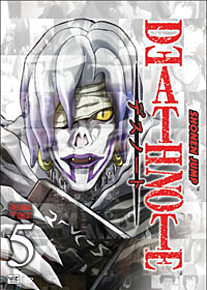Review
by Casey Brienza,Death Note
DVD 5
| Synopsis: |  |
||
L and the police have kept Light and Misa in confinement for fifty days, but Kira has not stopped killing, and they have not confessed. They pass a test devised by L that requires Light's father to put his own life on the line and are released. Even so, L does not trust them and places them under twenty-four hour surveillance. Light, he keeps handcuffed to him at all times. Though they have lost the support of law enforcement, the investigative team led by L is soon able to link Kira to the Yotsuba Group. Matsuda, driven by a bout of foolish initiative, sneaks into Yotsuba's Headquarters and discovers a secret cabal of businessmen who appear to be controlling the Kira murders. Light then gets in contact with one of their number in order to convince him to turn Kira in. |
|||
| Review: | |||
The problem with adaptations is that they tend to reproduce the flaws of their source material, and the Death Note anime is no exception. Like many popular series, the manga continued for far too long, and what could have been one of the greatest plots in Weekly Shounen Jump's venerable history became a flawed, inelegant cultural product (mis)shaped by commercial imperatives. Viz Media's fifth Death Note DVD, which includes episodes 17-20, unfortunately corresponds to the weakest of the manga's subplots. At its base, the series is a straightforward tale of good versus evil. L is the good guy; Light is the bad guy. If this were an ordinary, cookie-cutter iteration of that sort of plot, the story would be told from L's perspective. But what makes Death Note so interesting is that it is told from the villain's—Light's—perspective instead, and it is his character that is thoroughly developed, nuanced, and fleshed-out. L, by comparison, is pretty one-dimensional. It's kind of like the original Star Wars trilogy told from the Emperor's perspective, or the Harry Potter series told from Voldemort's. Even so, any astute viewer knows that good always triumphs over evil in the end (the Japanese taste for shades of moral gray aside), which naturally means that Light is doomed. Up until this volume, Light's descent into the Abyss was a well-paced, finely-crafted piece of narration. But now, Light has given up the Death Note and forgotten his Kira “calling,” and the plot as it should have been has screeched to an awkward halt. Of course, the point of the Yotsuba Group subplot is to forestall the aforementioned inevitable for as long as possible (the conclusion of a moneymaking series), and the obvious foot-dragging quickly wears on one's patience. And sure enough, two of the episodes here focus primarily upon the development of supporting characters Aizawa and Matsuda, which, though interesting, is not strictly necessary. It would not have been missed had it not been included in the first place. The Yotsuba executives likewise exist primarily as filler material, and their personalities are hardly developed at all. Character-wise, the most enjoyable moments involve the interaction between Light and L, and watching the two rivals beat each other up while handcuffed provides some vaguely amusing comic relief (not to mention a healthy helping of rich fodder for yaoi fangirls). Without a doubt, however, the high point of the anime is its distinctive aesthetic. Though the quality of the animation per se is about average for a TV series, Madhouse (Ninja Scroll; X) does the gothic fantasy/horror look better than pretty much anybody, and they were the perfect studio to bring Death Note to life. Character designs are invariably pitch-perfect, and the palette is gloomy yet decadently saturated. The anime's two opening sequences, both of which appear on this DVD, are deliciously disturbing—and well worth watching just by themselves on the basis of artistic merit. Both the Japanese and English language voice casts are convincing, albeit in their own unique ways. Most viewers will probably find that they prefer one over the other. The latter does not seem to have been chosen specifically to copy the former's execution, and interestingly, with the notable exception of the brilliant Kappei Yamaguchi as L, the English voice actors average significantly longer resumes. The two most important the extras on the DVD, a behind the scenes documentary and a commentary track for episode seventeen, spotlight them…though having Death Note interpreted by people who are not especially close to the anime in its original Japanese production context seems of dubious value. (Other DVD bonuses include production art and trailers.) The dark, angry sound of the soundtrack is likewise appropriate, though the head-banging, punk sound of the opening and ending themes will undoubtedly sound like undifferentiated noise to many. Anyway, Death Note continues to be a good series—arguably one of the strongest to have appeared at the beginning of the 21st century—even if it does start to go rapidly downhill from here and never quite lives up to the promise of early episodes. |
| Grade: | |||
|
Overall (dub) : B
Overall (sub) : B
Story : B-
Animation : B+
Art : A
Music : C+
+ Plenty of creative ambition, not to mention style to burn. |
|||
| discuss this in the forum (18 posts) | | |||
| Production Info: | ||
|
Full encyclopedia details about Release information about |
||